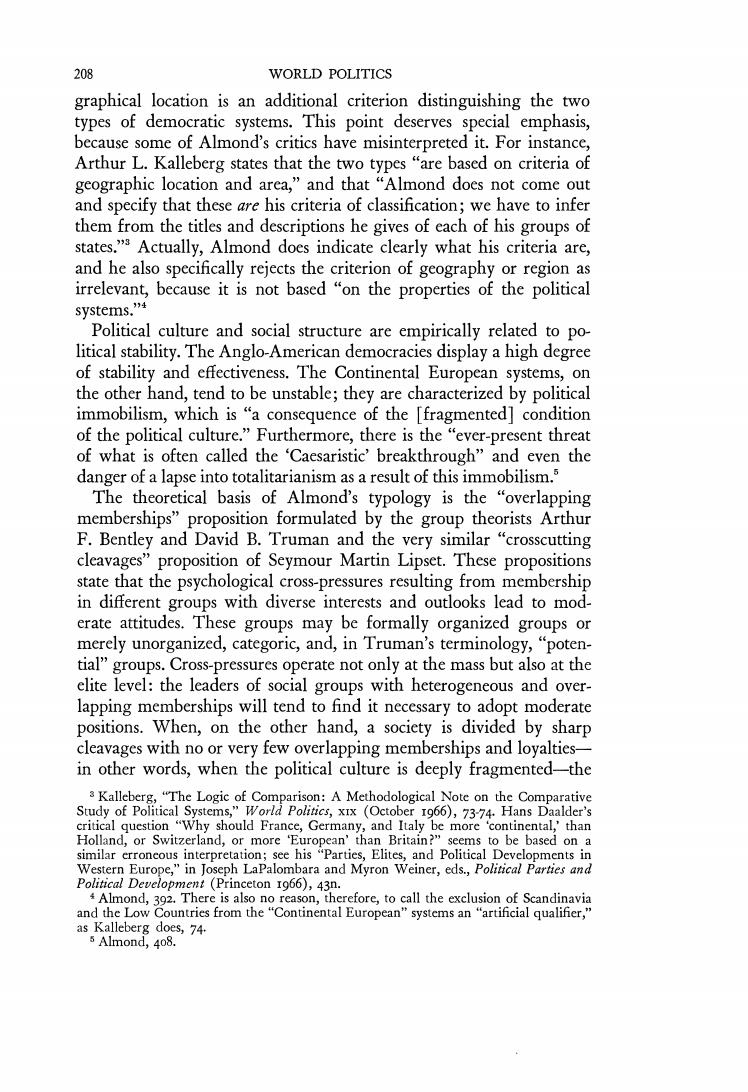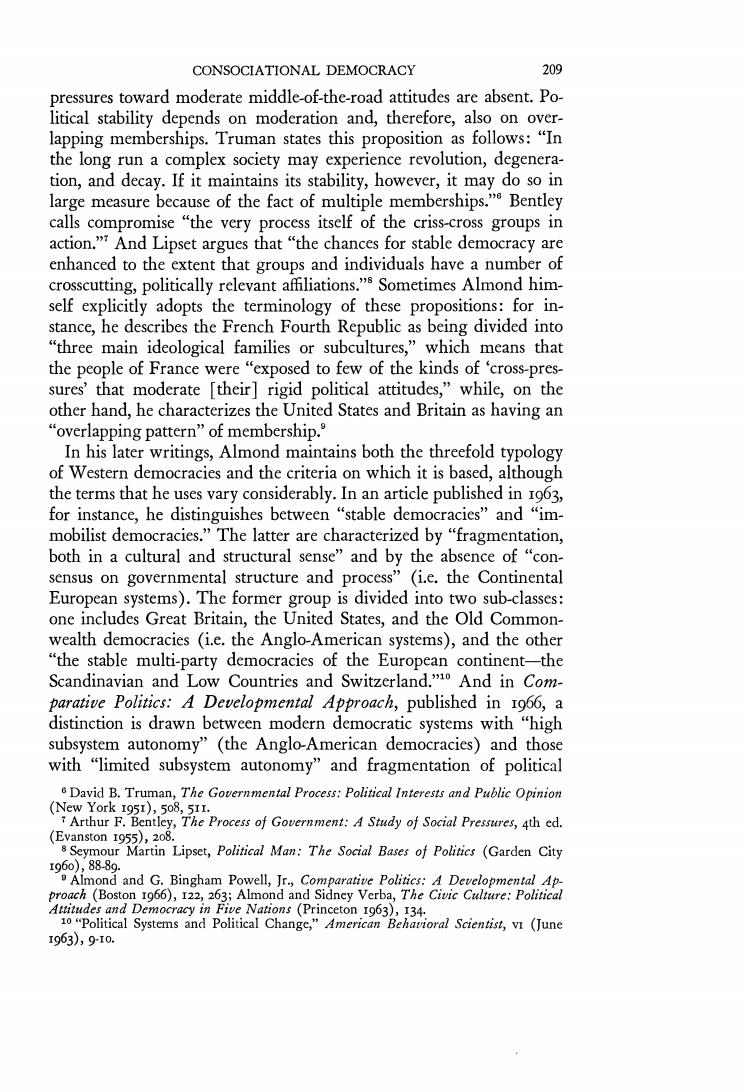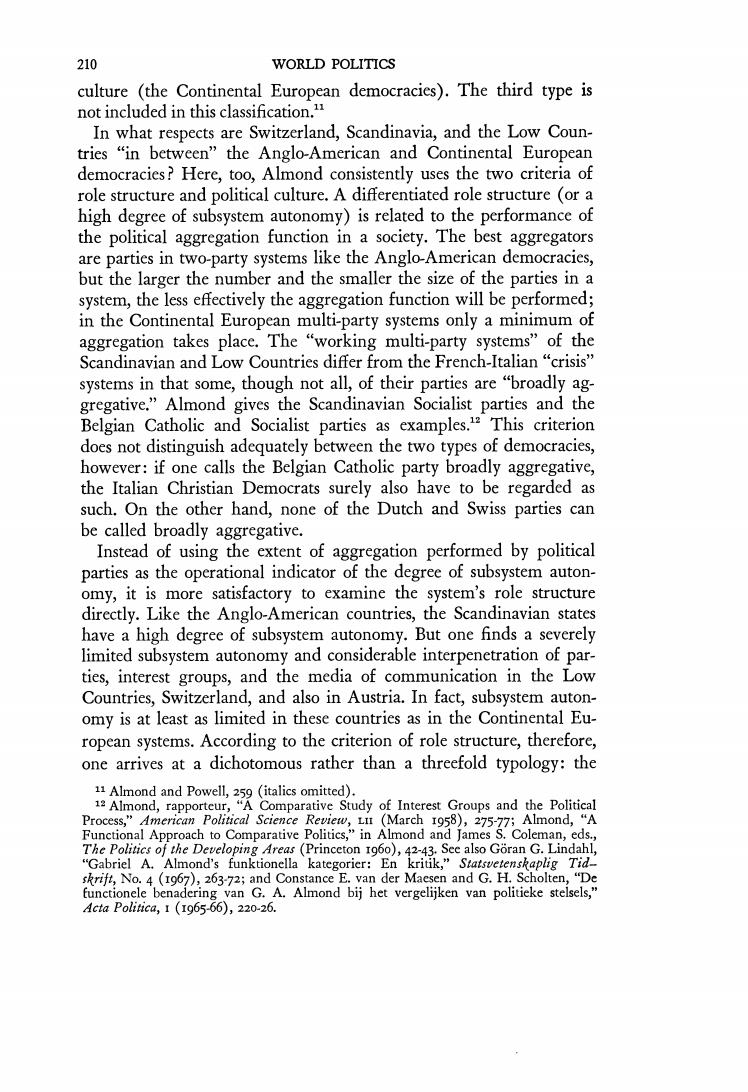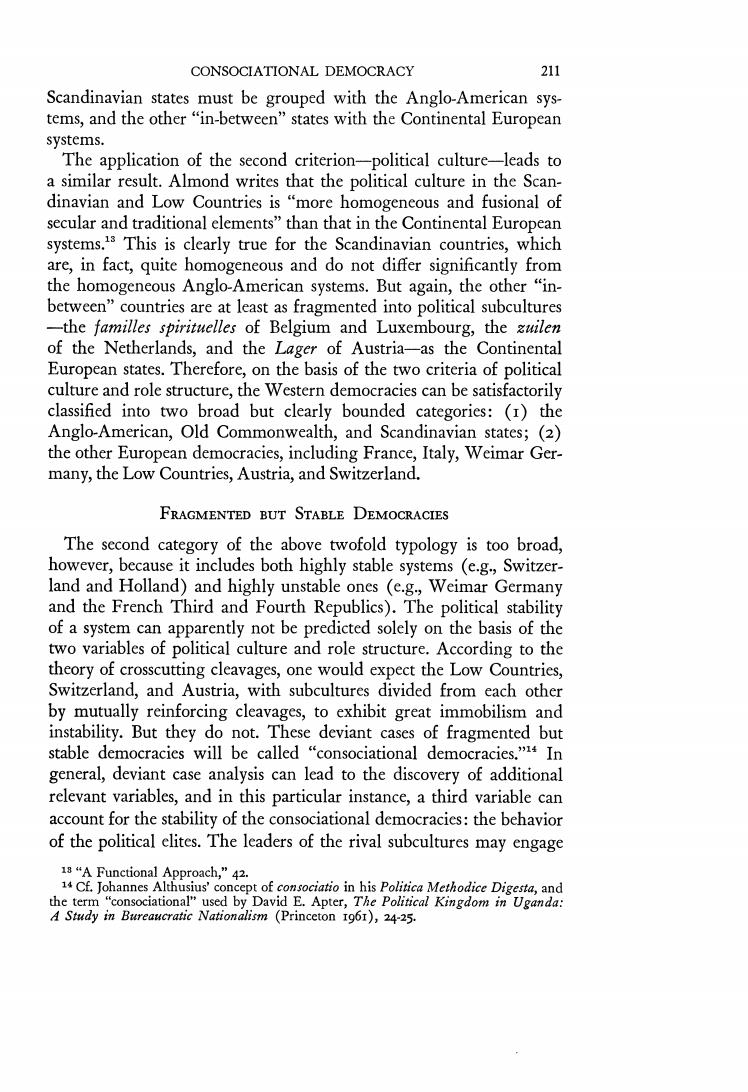
CONSOCIATIONAL DEMOCRACY By AREND LIJPHART* TYPES OF WESTERN DEMOCRATIC SYSTEMS TN Gabriel A.Almond's famous typology of political systems,first expounded in 1956,he distinguishes three types of Western demo- cratic systems:Anglo-American political systems (exemplified by Britain and the United States),Continental European political systems (France,Germany,and Italy),and a third category consisting of the Scandinavian and Low Countries.The third type is not given a distinct label and is not described in detail;Almond merely states that the coun- tries belonging to this type "combine some of the features of the Con- tinental European and the Anglo-American"political systems,and "stand somewhere in between the Continental pattern and the Anglo- American."Almond's threefold typology has been highly influential in the comparative analysis of democratic politics,although,like any provocative and insightful idea,it has also been criticized.This research note will discuss the concept of "consociational democracy"in a con- structive attempt to refine and elaborate Almond's typology of democracies. The typology derives its theoretical significance from the relationship it establishes between political culture and social structure on the one hand and political stability on the other hand.The Anglo-American systems have a "homogeneous,secular political culture"and a"highly differentiated"role structure,in which governmental agencies,parties, interest groups,and the communication media have specialized func- tions and are autonomous,although interdependent.In contrast,the Continental European democracies are characterized by a "fragmenta- tion of political culture"with separate "political sub-cultures."Their roles "are embedded in the sub-cultures and tend to constitute separate sub-systems of roles."2 The terms"Anglo-American"and "Continental European"are used for convenience only and do not imply that geo- This note represents an intermediate stage of a research project concerning political stability in democratic systems.An earlier and briefer discussion of the concept of consociational democracy,in the context of a critical analysis of the utility of typologies in comparative politics,appeared in the author's "Typologies of Democratic Systems," Comparative Political Studies,1 (April 1968),3-44.The author is indebted to the Insti- tute of International Studies,Berkeley,for financial support. 1Gabriel A.Almond,"Comparative Political Systems,"Journal of Politics,xvi (August I956),392-93,405. 2Ibid.,398-99,405-07 (italics omitted)

208 WORLD POLITICS graphical location is an additional criterion distinguishing the two types of democratic systems.This point deserves special emphasis, because some of Almond's critics have misinterpreted it.For instance, Arthur L.Kalleberg states that the two types"are based on criteria of geographic location and area,"and that"Almond does not come out and specify that these are his criteria of classification;we have to infer them from the titles and descriptions he gives of each of his groups of states."Actually,Almond does indicate clearly what his criteria are, and he also specifically rejects the criterion of geography or region as irrelevant,because it is not based"on the properties of the political systems."4 Political culture and social structure are empirically related to po- litical stability.The Anglo-American democracies display a high degree of stability and effectiveness.The Continental European systems,on the other hand,tend to be unstable;they are characterized by political immobilism,which is"a consequence of the [fragmented]condition of the political culture."Furthermore,there is the "ever-present threat of what is often called the 'Caesaristic'breakthrough"and even the danger of a lapse into totalitarianism as a result of this immobilism. The theoretical basis of Almond's typology is the "overlapping memberships"proposition formulated by the group theorists Arthur F.Bentley and David B.Truman and the very similar "crosscutting cleavages"proposition of Seymour Martin Lipset.These propositions state that the psychological cross-pressures resulting from membership in different groups with diverse interests and outlooks lead to mod- erate attitudes.These groups may be formally organized groups or merely unorganized,categoric,and,in Truman's terminology,"poten- tial"groups.Cross-pressures operate not only at the mass but also at the elite level:the leaders of social groups with heterogeneous and over- lapping memberships will tend to find it necessary to adopt moderate positions.When,on the other hand,a society is divided by sharp cleavages with no or very few overlapping memberships and loyalties- in other words,when the political culture is deeply fragmented-the 3 Kalleberg,"The Logic of Comparison:A Methodological Note on the Comparative Study of Political Systems,"World Politics,xIx (October 1966),7374.Hans Daalder's critical question "Why should France,Germany,and Italy be more 'continental,'than Holland,or Switzerland,or more 'European'than Britain?"seems to be based on a similar crroncous interpretation;see his "Parties,Elites,and Political Developments in Western Europe,"in Joseph LaPalombara and Myron Weiner,eds.,Political Parties and Political Development (Princeton 1966),43n. +Almond,392.There is also no reason,therefore,to call the exclusion of Scandinavia and the Low Countries from the“Continental European”systems an“artificial qualifier,” as Kalleberg does,74. 5 Almond,408

CONSOCIATIONAL DEMOCRACY 209 pressures toward moderate middle-of-the-road attitudes are absent.Po- litical stability depends on moderation and,therefore,also on over- lapping memberships.Truman states this proposition as follows:"In the long run a complex society may experience revolution,degenera- tion,and decay.If it maintains its stability,however,it may do so in large measure because of the fact of multiple memberships."Bentley calls compromise"the very process itself of the criss-cross groups in action.And Lipset argues that"the chances for stable democracy are enhanced to the extent that groups and individuals have a number of crosscutting,politically relevant affiliations.Sometimes Almond him- self explicitly adopts the terminology of these propositions:for in- stance,he describes the French Fourth Republic as being divided into "three main ideological families or subcultures,"which means that the people of France were "exposed to few of the kinds of 'cross-pres- sures'that moderate [their]rigid political attitudes,"while,on the other hand,he characterizes the United States and Britain as having an “overlapping pattern”of membership. In his later writings,Almond maintains both the threefold typology of Western democracies and the criteria on which it is based,although the terms that he uses vary considerably.In an article published in 1963, for instance,he distinguishes between "stable democracies"and "im- mobilist democracies."The latter are characterized by "fragmentation, both in a cultural and structural sense"and by the absence of "con- sensus on governmental structure and process"(i.e.the Continental European systems).The former group is divided into two sub-classes: one includes Great Britain,the United States,and the Old Common- wealth democracies (i.e.the Anglo-American systems),and the other "the stable multi-party democracies of the European continent-the Scandinavian and Low Countries and Switzerland."1 And in Com- parative Politics:A Developmental Approach,published in 1966,a distinction is drawn between modern democratic systems with "high subsystem autonomy"(the Anglo-American democracies)and those with "limited subsystem autonomy"and fragmentation of political David B.Truman,The Governmental Process:Political Interests and Public Opinion (New York I951),508,5II. 1Arthur F.Bentley,The Process of Government:A Study of Social Pressures,4th ed. (Evanston 1955),208. s Seymour Martin Lipset,Political Man:The Social Bases of Politics (Garden City I960),88-89. Almond and G.Bingham Powell,Jr.,Comparative Politics:A Developmental Ap- proach (Boston 1g66),122,263;Almond and Sidney Verba,The Civic Culture:Political Attitudes and Democracy in Five Nations (Princeton 1963),134. 10"Political Systems and Political Change,"American Behavioral Scientist,vI (June I963),9-I0

210 WORLD POLITICS culture (the Continental European democracies).The third type is not included in this classification. In what respects are Switzerland,Scandinavia,and the Low Coun- tries "in between"the Anglo-American and Continental European democracies?Here,too,Almond consistently uses the two criteria of role structure and political culture.A differentiated role structure (or a high degree of subsystem autonomy)is related to the performance of the political aggregation function in a society.The best aggregators are parties in two-party systems like the Anglo-American democracies, but the larger the number and the smaller the size of the parties in a system,the less effectively the aggregation function will be performed; in the Continental European multi-party systems only a minimum of aggregation takes place.The "working multi-party systems"of the Scandinavian and Low Countries differ from the French-Italian "crisis" systems in that some,though not all,of their parties are "broadly ag- gregative."Almond gives the Scandinavian Socialist parties and the Belgian Catholic and Socialist parties as examples.This criterion does not distinguish adequately between the two types of democracies, however:if one calls the Belgian Catholic party broadly aggregative, the Italian Christian Democrats surely also have to be regarded as such.On the other hand,none of the Dutch and Swiss parties can be called broadly aggregative. Instead of using the extent of aggregation performed by political parties as the operational indicator of the degree of subsystem auton- omy,it is more satisfactory to examine the system's role structure directly.Like the Anglo-American countries,the Scandinavian states have a high degree of subsystem autonomy.But one finds a severely limited subsystem autonomy and considerable interpenetration of par- ties,interest groups,and the media of communication in the Low Countries,Switzerland,and also in Austria.In fact,subsystem auton- omy is at least as limited in these countries as in the Continental Eu- ropean systems.According to the criterion of role structure,therefore, one arrives at a dichotomous rather than a threefold typology:the 11 Almond and Powell,259 (italics omitted). 1Almond,rapporteur,"A Comparative Study of Interest Groups and the Political Process,"American Political Science Review,Lit (March 1958),275-77;Almond,"A Functional Approach to Comparative Politics,"in Almond and James S.Coleman,eds., The Politics of the Developing Areas (Princeton 1960),42-43.Sec also Goran G.Lindahl, "Gabriel A.Almond's funktionella kategorier:En kritik,"Statsvetenskaplig Tid- skrift,No.4 (1967),263-72;and Constance E.van der Maesen and G.H.Scholten,"De functionele benadering van G.A.Almond bij het vergelijken van politieke stelsels," Acta Politica,1(I965-66),220-26

CONSOCIATIONAL DEMOCRACY 211 Scandinavian states must be grouped with the Anglo-American sys- tems,and the other"in-between"states with the Continental European systems. The application of the second criterion-political culture-leads to a similar result.Almond writes that the political culture in the Scan- dinavian and Low Countries is "more homogeneous and fusional of secular and traditional elements"than that in the Continental European systems.This is clearly true for the Scandinavian countries,which are,in fact,quite homogeneous and do not differ significantly from the homogeneous Anglo-American systems.But again,the other "in- between"countries are at least as fragmented into political subcultures -the familles spirituelles of Belgium and Luxembourg,the zuilen of the Netherlands,and the Lager of Austria-as the Continental European states.Therefore,on the basis of the two criteria of political culture and role structure,the Western democracies can be satisfactorily classified into two broad but clearly bounded categories:(I)the Anglo-American,Old Commonwealth,and Scandinavian states;(2) the other European democracies,including France,Italy,Weimar Ger- many,the Low Countries,Austria,and Switzerland. FRAGMENTED BUT STABLE DEMOCRACIES The second category of the above twofold typology is too broad, however,because it includes both highly stable systems (e.g,Switzer- land and Holland)and highly unstable ones (e.g,Weimar Germany and the French Third and Fourth Republics).The political stability of a system can apparently not be predicted solely on the basis of the two variables of political culture and role structure.According to the theory of crosscutting cleavages,one would expect the Low Countries, Switzerland,and Austria,with subcultures divided from each other by mutually reinforcing cleavages,to exhibit great immobilism and instability.But they do not.These deviant cases of fragmented but stable democracies will be called "consociational democracies."In general,deviant case analysis can lead to the discovery of additional relevant variables,and in this particular instance,a third variable can account for the stability of the consociational democracies:the behavior of the political elites.The leaders of the rival subcultures may engage 18“A Functional Approach,”42. 14 Cf.Johannes Althusius'concept of consociatio in his Politica Methodice Digesta,and the term "consociational"used by David E.Apter,The Political Kingdom in Uganda: A Study in Bureaucratic Nationalism (Princeton 1961),24-25